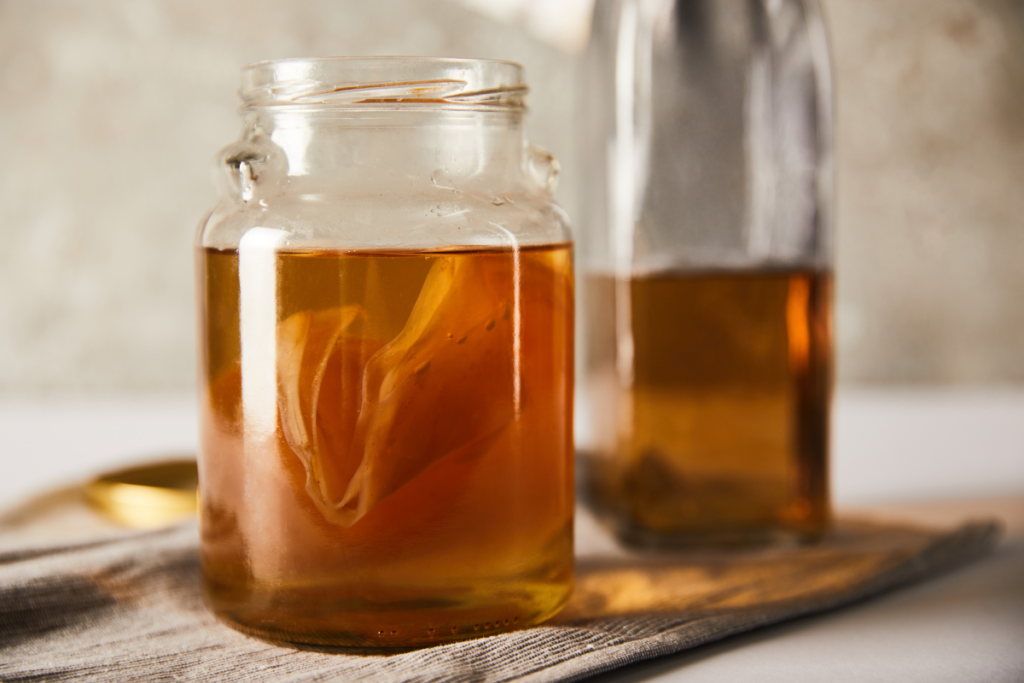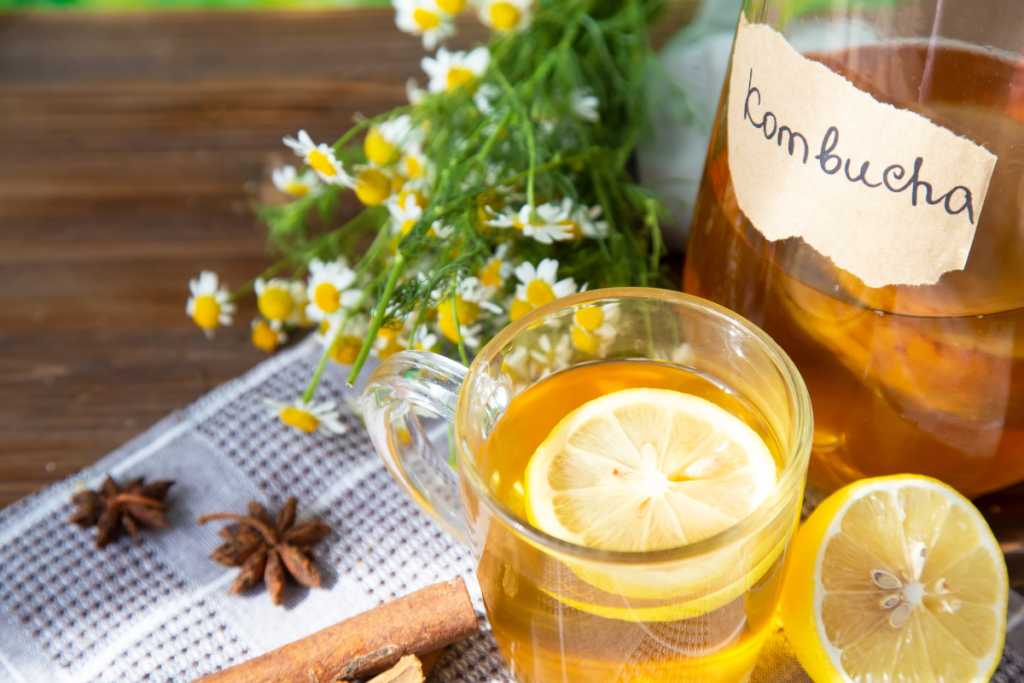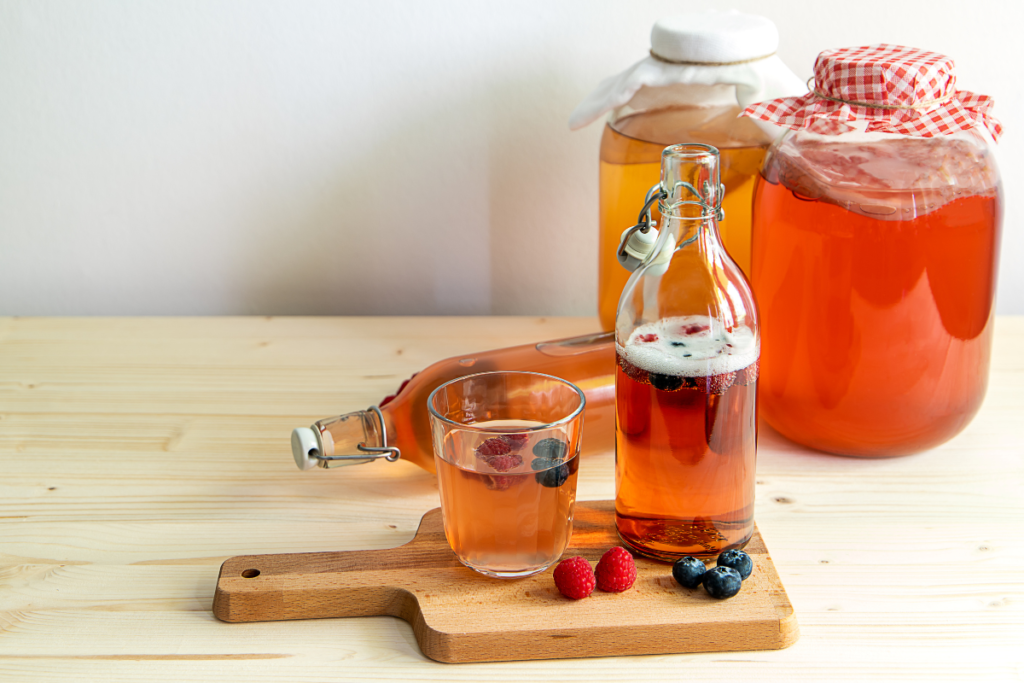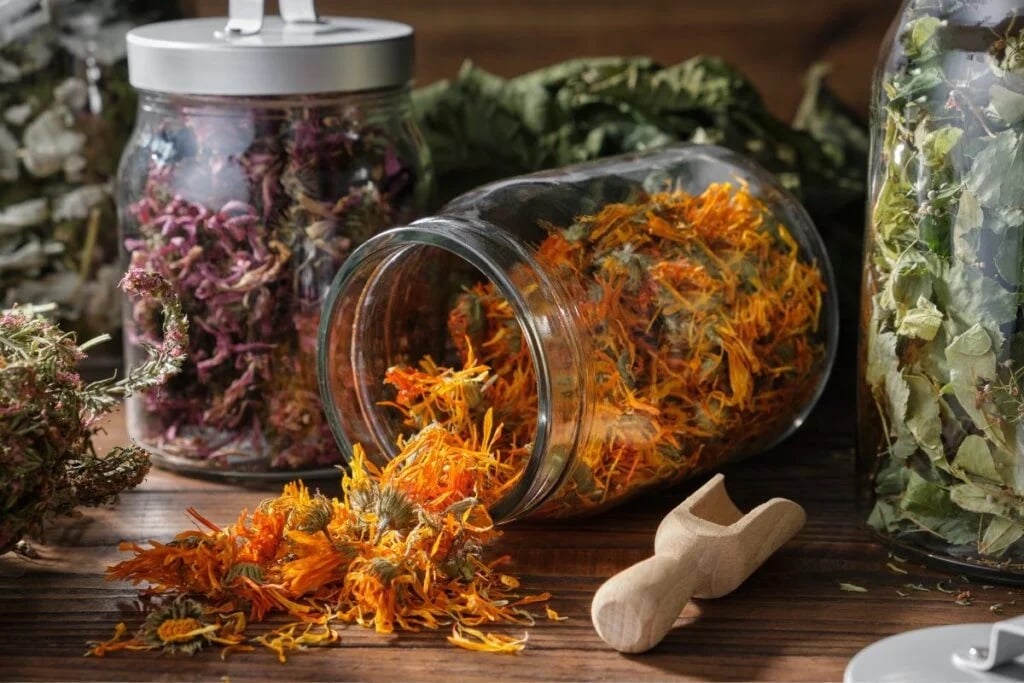It is believed that kombucha’s first existence came in Southeast China around 5,000 years ago. Legend suggests that a cup of sweetened tea was left on a windowsill, where acetic acid bacteria and wild yeast naturally colonized it. Over time, this microbial culture transformed the tea by consuming the sugar and fermenting it into a tangy, effervescent beverage. A gelatinous film began to form on the surface—a living culture that later became known as the “tea fungus” or “kombucha SCOBY.” This mushroom was carefully passed down through generations, spreading across cultures and continents to reach us today. Let’s discover the history, easy home brewing tips for this probiotic-rich drink, and explore kombucha tea benefits.
The Origins and Rise of Kombucha
Kombucha has long been regarded as a legendary elixir believed to promote longevity. People consumed it for its supposed healing powers and revered it as a cure-all elixir. While many of those early claims have not stood up to scientific scrutiny, one truth has remained—fungus tea, especially when well-fermented, is rich in probiotics that can support a healthy digestive system.
In the last ten years, tea fungus has seen a dramatic rise in popularity. The first major commercial brand, GT’s Kombucha, launched in the United States in 1995, paving the way for a global fermented tea movement. By the early 2000s, kombucha companies had sprung up worldwide, and the beverage began to evolve. No longer limited to a single sour flavor, producers began experimenting with fruits, herbs, and spices, giving rise to a wide range of unique and flavorful variations.
Today, fermented tea remains a favorite among health-conscious consumers. Valued for its natural ingredients, low sugar content, and probiotic benefits, it has also emerged as a popular alternative to alcohol, coffee, and sugary soft drinks. With only trace amounts of caffeine and alcohol, kombucha fits seamlessly into modern wellness lifestyles, and its growing popularity shows no signs of slowing down.

Kombucha Tea Benefits
Kombucha is more than just a fizzy fermented tea—it may offer benefits comparable to green tea. It has even been linked to protection against severe health conditions like diabetes and cancer. Rich in probiotics and antioxidants, mushroom tea delivers a wide range of potential health perks for the body:
- Fermented tea contains several strains of lactic acid bacteria, which can act as probiotics. These beneficial microbes help balance the gut microbiome, potentially improving digestion, reducing inflammation, and even aiding in weight management.
- When brewed with green tea, kombucha inherits many of the same health-supporting properties, such as aiding weight loss and helping regulate blood sugar levels. Similarly, fermented tea made from black or herbal teas may have unique advantages.
- Antioxidants found in kombucha help combat oxidative stress in the body, which can contribute to aging and chronic diseases. These compounds neutralize free radicals and support cellular health.
- Thanks to its tea polyphenols and acetic acid, this probiotic tea may inhibit the growth of harmful bacteria and yeast. Kombucha made from green or black tea has potent antimicrobial activity, helping to fight off infection-causing pathogens, including Candida.
- Some studies suggest kombucha may help reduce LDL (“bad”) cholesterol while increasing HDL (“good”), thereby supporting cardiovascular health and potentially lowering the risk of heart disease.
- By slowing the digestion of carbohydrates, mushroom tea can help reduce spikes in blood sugar. This may also improve liver and kidney function over time. Green tea-based fermented tea is effective, as green tea is known for its blood sugar-lowering effects.
- The high concentration of polyphenols and antioxidants in fermented tea may help prevent the growth and spread of cancerous cells, though more human studies are needed to confirm this effect.

How to Make Mushroom Tea at Home
Brewing kombucha at home is surprisingly easy—and a fun, rewarding process.
- Start by making sweet tea (green or black tea works best). To make 3 liters (approximately 3 quarts) of water, combine 6 tablespoons of loose-leaf tea with 1 cup of sugar.
- Let the tea cool to room temperature, and add your SCOBY (symbiotic culture of bacteria and yeast). For 3 liters of tea, use 300–500 ml of starter liquid, the SCOBY.
- Allow it to ferment at room temperature for about 10–15 days, leading the tea to lose its sweetness and develop a tangy, effervescent profile. Cover the jar with a breathable cloth (not a lid) to allow airflow while keeping out dust and insects.
- Remove the SCOBY and set aside 300–500 ml of kombucha for your next batch.
- Bottle the remaining kombucha. You may enjoy it as is or flavor it with fruits, herbs, and spices. If left at room temperature for a few more days, the bottled kombucha will go through a second fermentation, becoming fizzy and full of character.
Begin creativity by flavoring your fermented tea—there are endless combinations of herbs, spices, fruits, and flowers. Here’s one of the most popular flavor variations:

Ginger Kombucha
Ginger kombucha is a beloved classic with a zesty bite and a lightly sweet, tangy finish, reminiscent of apple cider vinegar and black tea.
You’ll need:
- 3 liters of finished kombucha brewed with black tea (from the base recipe above)
- 170 grams (about 6 oz) of fresh ginger root—for added digestive support, anti-inflammatory benefits, and a warming spice
- ½ cup of honey (or your preferred sweetener, such as fruit juice or sugar)—this provides natural sugars for the second fermentation.
- 1 cup of water (for the syrup)
How to make it:
- Brew the base kombucha with simple black tea and sugar. Do not add flavorings to the initial brew—this helps keep your SCOBY healthy, as flavor additives can damage or weaken it over time.
- Make a ginger syrup by simmering chopped ginger root in water. Let it cool, stir in the honey, and strain the ginger solids.
- Remove the SCOBY from your kombucha and gently stir the remaining liquid to balance the yeast (which settles at the bottom) and the bacteria (which tend to float at the top).
- Combine the syrup with the fungus tea, mixing gently. Pour into clean glass bottles, leaving a little headroom at the top. Seal tightly and store at room temperature out of direct sunlight for up to 3 days. This process ensures the second fermentation. Warmer rooms speed up fermentation; cooler environments slow it down.
- Transfer the bottles to the fridge and chill for at least 2 days. This helps carbonate the drink and stabilize the flavor.
- Open carefully over a sink! Homemade ginger kombucha can get extremely fizzy—or even explosive—thanks to its natural carbonation.
Lemon & Ginger Kombucha
For a zesty, refreshing twist, try lemon and ginger kombucha. To 750 ml (about 3 cups) of finished kombucha, add the juice of one lemon, a bit of its grated zest, and 1–2 teaspoons of freshly grated ginger. Stir well and pour the mixture into a glass bottle. Seal it tightly and leave it at room temperature for 2–4 days to ferment. Taste daily to track the flavor and fizziness. Strain the fermented beverage and chill before serving once you’re delighted with the result. Most people find it more enjoyable when served cold.
Berry-Flavored Mushroom Tea
To make a fruity version, take 750 ml of plain kombucha and stir in a handful of crushed or pureed berries—strawberries, blueberries, raspberries, or a mix of your favorites. Bottle the mixture in a clean glass container with a tight-fitting lid. Let it sit at room temperature for 2–4 days for the second fermentation. Check the taste daily. Once the kombucha is carbonated to your liking, strain out the solids and refrigerate the drink before enjoying.

Possible Side Effects of Fermented Tea
While tea fungus is often praised for its probiotic content and health-boosting qualities, you must brew and store it properly at home. If contaminated or over-fermented, kombucha can pose severe health risks, including intense illness or, in rare cases, death. Homemade batches may contain up to 3% alcohol due to natural fermentation.
Many prefer to buy fungus tea from trusted commercial brands for safety and consistency. Store-bought versions are typically labeled as non-alcoholic and must contain less than 0.5% alcohol by volume. Always read the ingredient list and avoid products with excessive added sugars.
Some believe tea fungus helps with chronic conditions, but scientific research offers limited support for many of these health claims. Experts recommend limiting intake to about one cup (240 ml) daily to enjoy kombucha safely.
Potential Risks of Drinking Too Much Kombucha
- High Calorie Content: A single bottle can contain up to 120 calories. Drinking several cups per day may contribute to unwanted weight gain. Unlike solid foods, liquid calories are less filling and can displace more nutritious snacks or meals.
- Digestive Discomfort: Despite its probiotic tea benefits, excessive consumption may cause bloating or gas. Carbonated drinks introduce carbon dioxide (CO₂) into the digestive system, resulting in uncomfortable pressure or distension.
- Added Sugars: Many commercial brands sweeten their kombucha with fruit juice or cane sugar to make it more appealing. This boosts the sugar content, potentially increasing your risk of developing diabetes, obesity, or heart disease.
- Risk for Immunocompromised Individuals: Because probiotic tea is unpasteurized and contains a mix of live bacteria and yeasts, it can encourage the growth of harmful microbes in people with weakened immune systems.
- Though rare, allergic reactions to kombucha or its ingredients are possible.
- Pregnancy & Breastfeeding Concerns: Healthcare specialists do not recommend this tea fungus during pregnancy or while breastfeeding due to its unpasteurized nature and small amounts of caffeine and alcohol.
- Caffeine Sensitivity: While mushroom tea contains less caffeine than regular brewed tea, excessive intake could still lead to jitters, anxiety, or disrupted sleep, especially in those sensitive to stimulants.
Sources:
- https://health.unl.edu/kombucha-what-it-and-what-are-its-health-benefits
- https://www.healthline.com/nutrition/8-benefits-of-kombucha-tea
- https://revolutionfermentation.com/en/blogs/kombucha/kombucha-origins/
- https://www.britannica.com/topic/kombucha
- https://www.ncbi.nlm.nih.gov/pmc/articles/PMC9975612/
- https://www.ncbi.nlm.nih.gov/pmc/articles/PMC9265386/
- https://research.kombuchabrewers.org/
Associative photos © Canva.

